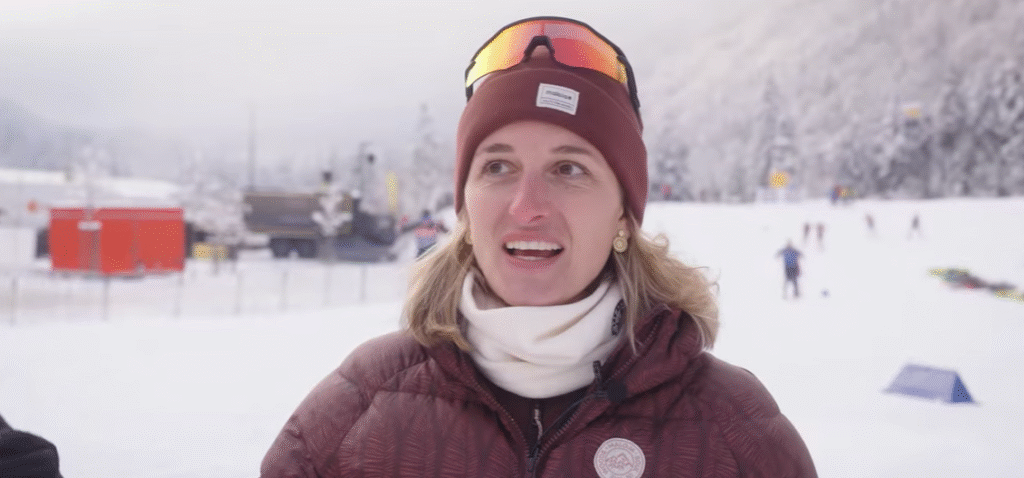Vanessa Hinz – Biographical Overview
| Attribute | Details |
|---|---|
| Name | Vanessa Hinz |
| Date of Birth | March 24, 1992 |
| Birthplace | Munich, Germany |
| Height | 1.76 m |
| Weight | 61 kg |
| Residence | Schliersee, Germany |
| Sports Club | SC Schliersee |
| Profession | Former Biathlete, Customs Officer |
| Major Achievements | 3× World Champion (relay), Olympic Bronze (2022), 7× World Championship medals |
| Career Span (Biathlon) | 2012–2023 |
| Social Media | Instagram @vanessa_hinz_ |
| Official Bio | https://en.wikipedia.org/wiki/Vanessa_Hinz |

Vanessa Hinz’s name has become remarkably synonymous with quiet excellence in German biathlon over the last ten years. She carved out an incredibly stable and successful athletic career without ever trying to project a celebrity aura. Hinz, who was born in Munich and reared in the sleepy town of Schliersee, grew up surrounded by mountain scenery that later reflected her inner landscape: steady, introspective, but resilient under duress. She started out in cross-country skiing before switching to biathlon in 2012, which significantly changed her career trajectory.
She was already contributing significantly by 2013, winning gold in the relay at the European Championships. But it wasn’t until she won two golds in the relay and mixed relay events at the 2017 World Championships in Hochfilzen that she became well-known. These victories were more than just personal victories; they solidified her standing as a team format anchor who excels at performing under duress.
In 2018, she made her Olympic debut in Pyeongchang, where she just missed placing on the podium. However, her name was inscribed in Olympic history during the 2022 Winter Games in Beijing. In the 4×6 km relay, she won bronze with teammates Franziska Preuss and Denise Herrmann-Wick. Particularly since it came after a protracted recuperation from a severe shoulder injury in 2020, that race—which was marked by icy conditions and tactical shuffling—became one of her defining moments. Returning to medal contention after surgery is intimidating for any athlete, but Vanessa made it seem methodical.
Over the course of her athletic career, Vanessa significantly raised her World Cup rankings each year. She won a personal gold in the 12.5 km mass start in Kontiolahti during her exceptional 2017–18 season. In addition to being statistically significant, that victory had emotional resonance. It demonstrated that a composed and extremely productive work ethic could still be seen in a time when media-centric personas and flamboyant figures predominated.
She stayed quiet in public, avoiding talking about romantic relationships or personal hardships. She frequently brought up her training, team dynamics, and strategic focus in interviews and press appearances. This deliberate separation preserved her mental clarity, a decision remarkably similar to that of other private athletes, such as the legendary biathlete Ole Einar Bjørndalen or Roger Federer in his youth. She was able to escape the draining pressures of both performance and constant public scrutiny by doing this.
Vanessa only shared pictures of her training sessions, team parties, and alpine hikes while fans conjectured about her romantic life. With almost 60,000 devoted followers, her Instagram turned into a digital journal of her career, devoid of drama and brimming with self-control. Especially among young athletes looking for role models who prioritize stability over spectacle, that authenticity fostered trust.
She also exhibits a grounded mindset by choosing to train at the highest level and work as a customs officer. It took more than just common sense to juggle two occupations, particularly one related to public service. It was a deliberate investment in a life outside of athletics. This strategy is especially helpful when it comes to athletic retirement, which many people experience along with identity crises and unstable finances. With foresight, Hinz planned her post-sport path, guaranteeing continuity when the competition days came to an end.
Her association with Maloja Clothing and her conspicuous attendance at US Biathlon competitions in recent months suggested a possible shift toward brand ambassadorship or mentoring. Her experience is very valuable, whether she is coaching or working with athletic development programs. Her story provides insight into flexibility and long-term planning, especially for athletes juggling post-injury recovery or switching sports.
Vanessa hasn’t completely vanished from the public eye despite her retirement. On her own terms, she still interacts with the sports community. Public respect has not decreased as a result of her decision to stop actively competing. If anything, there is now more respect. particularly because she departed when she was still capable of performing, highlighting her belief that it is better to leave with dignity than to put things off.
There are a few possible paths for those who are curious about her next moves. Given her exceptionally clear communication style, she could easily transition into a technical role with the German Ski Association or take on media commentary assignments. On the other hand, athlete education programs that emphasize career planning, mental toughness, and performance under pressure would benefit greatly from her cool authority.
Hinz created a public persona that will probably hold up better than most because he chose moderation over publicity. She never leaned into gossip, traded discipline for digital relevance, or used her personal life as a means of engagement. Today, when consistency is frequently overshadowed by visibility, that is especially uncommon.
Vanessa Hinz serves as a subtle yet effective role model for young women in sports, particularly those who are torn between media and performance metrics. Her tale serves as a reminder that being extremely productive, calm under pressure, and subtly driven can be just as captivating as any publicity.
